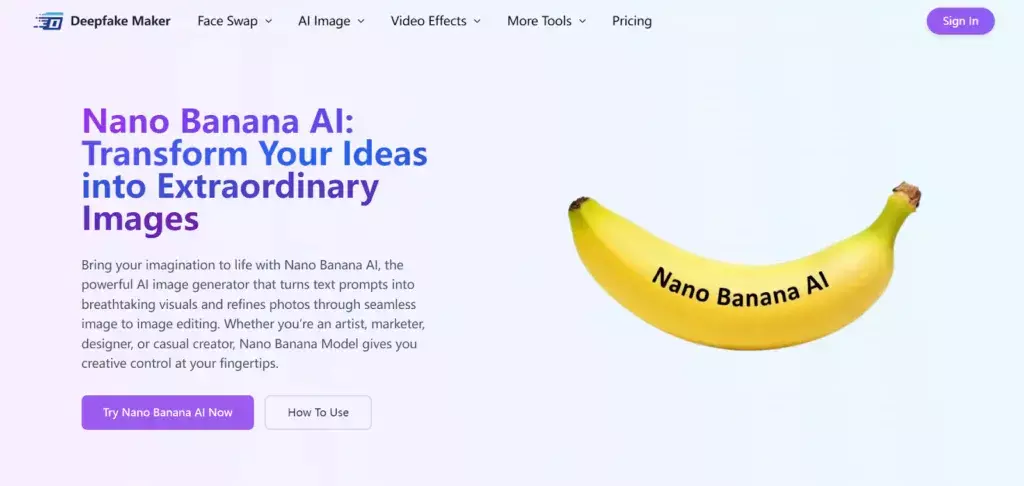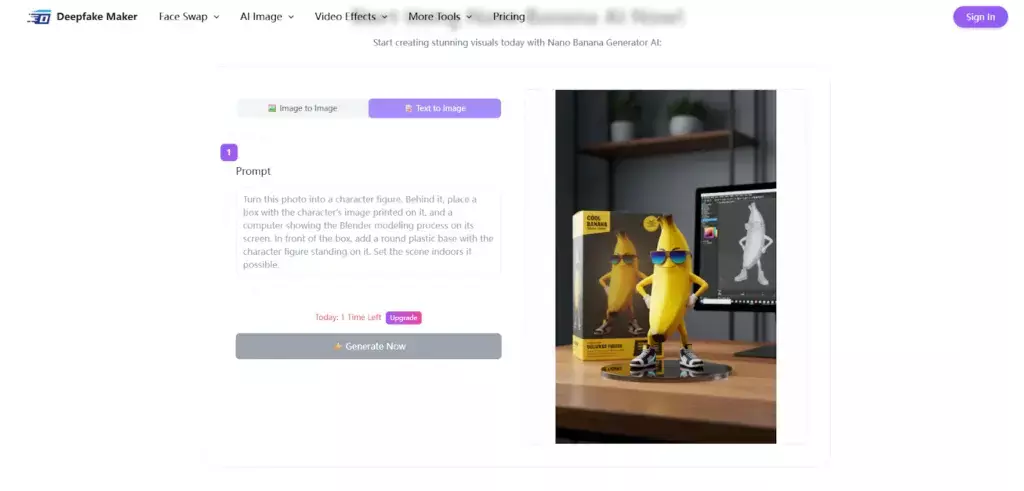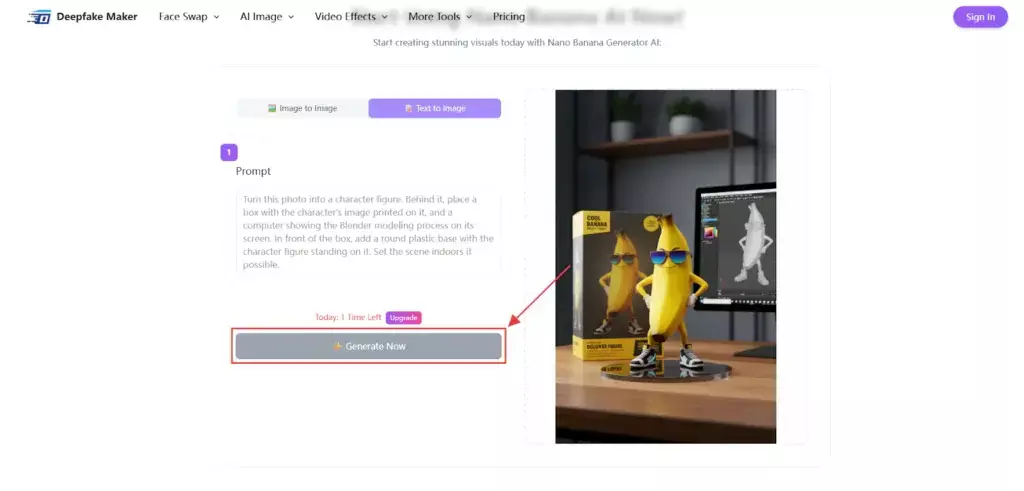From Chaos To Campaign: How One Marketer Shipped A Month Of Visuals In A Weekend With Nano Banana AI By Deepfake Maker
There’s no way I ship a full month of visuals by Monday,” this guide is for you. Nano Banana AI inside Deepfake Maker turns that anxiety into a repeatable system: describe what you want
If you’ve ever stared at a chaotic folder of half-edited photos and thought, “There’s no way I ship a full month of visuals by Monday,” this guide is for you. Nano Banana AI inside Deepfake Maker turns that anxiety into a repeatable system: describe what you want, upload what you have, and quickly generate on-brand images you can actually use across ads, social, emails, and landing pages. In the next sections, you’ll see exactly how Nano Banana AI helps a solo marketer go from scattered assets to a cohesive campaign—without new headcount, pricey stock libraries, or twelve different apps.
Table of Contents
- The Real-World Scenario We’ll Solve
- What Is Nano Banana AI
- Why Deepfake Maker + Nano Banana AI Is A Smart Stack
- The Before State: Pain Points You Probably Recognize
- The After State: What Changes When You Use Nano Banana AI
- How to Use Deepfake Maker Nano Banana AI in 3 Steps
- Brand Consistency: Prompts, References, and Style Lock
- Productivity Math: Hours Saved, Assets Shipped
- Ethical & Safe Usage (What To Do / Not To Do)
- Troubleshooting: When Results Miss The Mark
- Advanced Tips: Iteration, Variants, and Batch Work
- FAQ: Nano Banana AI On Deepfake Maker
- Conclusion
The Real-World Scenario We’ll Solve
Meet Maya, a one-woman marketing team for a niche e-commerce brand. Black Friday and a holiday bundle launch are two weeks away. Her to-do list is a thicket of “ASAPs”: ads, email headers, social carousels, landing-page heros, a handful of Pinterest pins, plus evergreen imagery for the store. She’s got a budget that won’t stretch to a full photo shoot and a folder stuffed with “almost good” product photos—mixed lighting, cluttered backgrounds, and inconsistent angles.
Goal: Produce a month of on-brand visuals—polished enough for ads and cohesive enough to make the grid look like a single art director handled everything.
Constraint: Time. Maya needs velocity, not just quality. She can’t spend 40 hours in a raster editor. She needs a system that turns ideas into images quickly and predictably.
Solution preview: Nano Banana AI on Deepfake Maker. With it, Maya combines two complementary powers:
- Text-to-image to explore bold hero concepts from a written description.
- Image-to-image to restyle and standardize her existing photos without losing the product’s true shape, label, or color.
What Is Nano Banana AI
Nano Banana AI is an AI image model that both generates brand-new images and transforms your existing photos to match a desired aesthetic. Think of it as a creative partner that speaks in plain English:

- Tell it what you want—lighting, mood, surface, palette—and it proposes options.
- Upload what you already have—your product shots, brand references—and it harmonizes them into a consistent style.
Inside Deepfake Maker, Nano Banana AI is presented in a clean, practical interface that keeps the focus on outcomes rather than knobs. You can start with a blank prompt for ideation or drop in a product photo and say “keep the geometry, change the background, give me soft daylight and a reflective acrylic base.” Because Nano Banana AI understands both generation and transformation, it’s equally useful for first drafts and final polish—and it’s fast enough to invite iteration.
Why Deepfake Maker + Nano Banana AI Is A Smart Stack
One workspace, two modes. Deepfake Maker wraps Nano Banana AI in a flow that lets you brainstorm from scratch (text-to-image) and then brings your real assets up to the same standard (image-to-image). You don’t need to bounce between five tools or learn a new editing paradigm—just prompt, preview, adjust.
Speed to first draft. The first preview arrives quickly, which encourages “micro-iterations”: you change one thing, evaluate, lock it in, and move on. That loop is where most of the time savings come from.
Beginner-friendly, expert-capable. The UI surfaces what matters—prompt, references, and export—without burying you in jargon. Power comes from the Nano Banana AI model and your prompt discipline, not a maze of sliders.
Brand-quality outputs. You can aim for clean e-commerce clarity, moody editorial, or high-contrast ad aesthetics. With the right prompt vocabulary, Nano Banana AI yields images that are consistent enough to ship without a design meltdown in the comments.
The Before State: Pain Points You Probably Recognize
- Inconsistent lighting and backgrounds. Side-by-side, your grid looks like a collage of different decades.
- Template fatigue. Stock layout generators feel generic and off-brand.
- Time starvation. Building 20–40 unique assets across five channels by hand is slow.
- Budget pressure. Hiring for every micro-task blows through the month’s marketing spend.
- Creative block. You know the look you want but can’t produce it at volume or speed.
Maya started in exactly this hole. Nano Banana AI gave her a predictable climb-out path.
The After State: What Changes When You Use Nano Banana AI
After a weekend with Nano Banana AI on Deepfake Maker, Maya had:
- A repeatable style kit—a few lines of prompt text she could paste anywhere to reproduce the look.
- Uniform, on-brand imagery—lighting, surfaces, and color palette in sync across assets.
- Variety without chaos—two or three distinct moods for A/B testing, each consistent within itself.
- Time back—a week’s worth of production compressed into a day or two of focused iteration.
The magic wasn’t a single hero image; it was a system that delivered heros, details, banners, and social crops that felt art-directed by the same brain.
How to Use Deepfake Maker Nano Banana AI in 3 Steps
Choose Mode & Provide Inputs
Open Deepfake Maker → launch Nano Banana AI.
Pick one:

Text-to-Image (generate from a description). Use a short prompt: subject (what’s in frame), lighting (e.g., soft daylight), surface/background (e.g., reflective acrylic, airy negative space), brand palette (hex codes), plus quality hints (photographic realism, clean shadows).
- Example: “Hero composition for matte skincare bottle, soft daylight studio, reflective acrylic base, airy negative space, teal/charcoal brand accents, photographic realism, label clearly readable.”

Image-to-Image (transform an uploaded photo). Upload your image and state what to preserve (geometry, label, true colors) vs. what to change (background, lighting, minor blemishes).
- Example: “Preserve product geometry and label; cool daylight; soft rim light; reduce harsh specular highlights; maintain teal/charcoal harmony; clean shadow falloff.”

Refine Quickly & Lock Your Style
Generate previews, then iterate with small, single-variable edits (only lighting or surface or camera angle per pass).
Create a reusable style kit (copy/paste block) for consistent results:
- Lighting: “soft daylight studio, gentle rim light, subtle grain.”
- Surface: “reflective acrylic base, airy negative space.”
- Palette: “strict teal/charcoal (#00A0A0 / #2B2B2B).”
Quality: “photographic realism, clean shadows, label readable.”
Add negative prompts to avoid issues: “no label distortion, no harsh speculars.”
- When labels warp: “preserve label geometry, no distortion.”

Export For Channels & Reuse
Export in the formats you need (e.g., 1:1 grid, 4:5 feed, 9:16 stories/reels, 1200×628 ad banners). Keep composition consistent and leave negative space where copy will sit.
Name files predictably (e.g., brand_product_mood_size_variant) and save your style kit for the next batch so Nano Banana AI on Deepfake Maker reproduces the same look in minutes.
Brand Consistency: Prompts, References, And Style Lock
Nano Banana AI rewards clarity. Prompt like a creative director:
- Reference images. Upload one or two “gold standards” to anchor color, lens mood, and surface.
- Fixed tokens. Reuse key phrases that define your signature: “reflective acrylic base,” “soft rim light,” “teal/charcoal accent,” “airy negative space.”
- Negative prompts. Prohibit failure modes: “no warped labels,” “no plastic reflections,” “no harsh specular highlights.”
- Iterative logging. Keep a tiny spreadsheet of prompt variants and outcomes. In three or four rounds, you’ll discover the minimal set of words that make Nano Banana AI deliver “your brand” on demand.
A style kit turns experimentation into production. Anyone on your team can paste it into Deepfake Maker, switch the subject line, and output visuals indistinguishable from the originals.
Productivity Math: Hours Saved, Assets Shipped
Let’s compare a typical manual workflow to Nano Banana AI inside Deepfake Maker.
Traditional path to 30 deliverables:
- Moodboard & planning: 4–6 hours
- Sourcing stock & licensing: 3–5 hours
- Manual editing per asset: 20–40 minutes × 30 = 10–20 hours
- Total: ~17–31 hours
With Nano Banana AI on Deepfake Maker:
- Prompting & setup: 1.5–2 hours
- Batch generation: 30–60 minutes
- Selection & light retouch: 10–15 minutes × 30 = 5–7.5 hours
- Total: ~7–10.5 hours
Net savings: 10–20+ hours per content cycle. That’s time you can reinvest in media buying, creative testing, or Q4 planning instead of painstaking background cleanups.
Ethical & Safe Usage (What To Do / Not To Do)
Do:
- Generate original scenes for your own products and brand imagery.
- Edit photos you own or have explicit rights to use.
- Be transparent in advertising — Nano Banana AI should enhance clarity, not misrepresent features.
Don’t:
- Impersonate real people or use others’ likenesses without consent.
- Lift trademarked graphics or proprietary packaging assets without permission.
- Conceal material edits in regulated categories (cosmetics, health claims, etc.).
Create a lightweight approval log—prompts used, inputs uploaded, and final assets selected—so compliance is straightforward if anybody asks.
Troubleshooting: When Results Miss The Mark
- Warped labels or skewed geometry? Add: “preserve label geometry, no distortion, straight edges.”
- Plastic-like reflections? Use: “matte finish, diffused light, reduced specular highlights.”
- Color drift from your palette? Include exact hex codes and “strict brand palette.”
- Too stylized / uncanny? Add: “photographic realism, natural shadows, real lens optics, depth falloff.”
- Cramped composition? Request: “generous negative space, rule-of-thirds placement.”
- Shadow issues? Specify: “natural soft contact shadow, smooth falloff.”
- Inconsistent angle across a set? Lock: “fixed camera height, consistent 45° angle.”
If an output is close but not perfect, use image-to-image with that near-miss as the new input. A tiny prompt nudge often lands exactly where you want.
Advanced Tips: Iteration, Variants, And Batch Work
- Prompt Blocks = Lego Bricks. Split your prompt into modules—subject, lighting, surface, palette, quality—and mix them to create families of images that still feel cohesive with Nano Banana AI.
- Two Moods, One Campaign. Produce “daylight acrylic” and “dusk concrete” themes. Run both in ads; let data pick the winner.
- Storyboard Carousels. For a carousel, design a hero frame, two context frames, and a detail frame. Use image-to-image so the set shares angle and light.
- Macro + Detail Pairing. Always pair a wide hero with a tight texture or label shot. The contrast adds depth to your product narrative.
- Typography After the Fact. Keep the image clean; reserve negative space. Add type in your design tool with brand fonts to avoid re-rendering.
- Export Discipline. Save master images at the largest practical resolution. Downscale for channels; never upscale from a tiny export.
- Style Hand-Off. Keep your Nano Banana AI style kit in a readme so teammates can reproduce your look in Deepfake Maker without guesswork.
FAQ: Nano Banana AI On Deepfake Maker
Q1: What exactly is Nano Banana AI inside Deepfake Maker?
A: It’s an AI image system that supports text-to-image (generate from a description) and image-to-image (transform an uploaded photo) within a single, practical interface. Nano Banana AI is tailored for fast ideation and consistent refinements, making it ideal for marketers, creators, and e-commerce teams.
Q2: Can I control style and keep my brand’s look?
A: Yes. Provide reference images, specify your brand palette with hex codes, and reuse a small style kit of prompt phrases. Over a few iterations, Nano Banana AI reproduces a recognizable brand language on demand.
Q3: How is this different from stitching together several apps?
A: With Deepfake Maker, both generation and editing happen in one place. That continuity reduces context switching, keeps quality consistent, and speeds up production—especially when you’re iterating rapidly.
Q4: What file quality can I expect?
A: High-quality assets fit for digital channels and lightweight print when exported properly. For print needs, do a quick upscale and check edges, text, and gradients before sending to the printer.
Q5: I’m new to AI image tools—will this be hard?
A: Not at all. Start with short prompts and adjust one variable at a time. Nano Banana AI gives fast previews so you learn by doing.
Q6: Is it safe and ethical to use?
A: Yes—use assets you own or have permission to edit, avoid impersonation, and be transparent in ads. Keep a prompt/output log if you operate in a regulated category.
Q7: Can Nano Banana AI help with variety without making my feed chaotic?
A: Absolutely. Anchor your look with a stable style kit and vary just one or two elements per batch—like background mood or crop ratio. The result is variety that still feels coherent.
Q8: Does this work for service brands or creators?
A: Yes. Replace “product” with an icon, mascot, scene, or typographic motif. Nano Banana AI can generate editorial illustrations, thumbnails, and lightweight brand visuals just as well as product imagery.
Q9: Can I blend multiple references?
A: Provide a primary reference to set the look and, if needed, a secondary to cue composition. In image-to-image, be explicit about what to preserve (geometry, label) so Nano Banana AI stays faithful to the source.
Q10: How fast is the overall process?
A: Expect seconds to a first preview and minutes to a polished set once your style kit is dialed in. Most users report shipping an entire content week in a single focused session.
Conclusion
You don’t need a dozen apps or a full-time art director to look like one. Nano Banana AI on Deepfake Maker compresses the distance between “I know what I want” and “it’s ready to publish.” For Maya, that meant turning a mess of half-edited photos into a month of cohesive visuals—ads, banners, thumbnails, and social posts—in a single weekend.
If you’re juggling strategy, copy, and reporting, let Nano Banana AI handle the heavy lifting on visuals:
- Draft a two-sentence style brief (lighting, surface, palette, lens mood).
- Generate two hero concepts via text-to-image in Deepfake Maker.
- Standardize your current photos with image-to-image.
- Save your style kit and replicate on demand.
Ready to try it? Open Deepfake Maker, launch Nano Banana AI, and ship your first on-brand set today. Your future self—the one not scrambling on Sunday night—will thank you.

